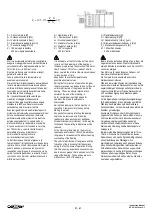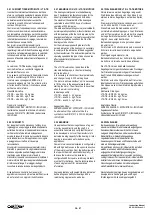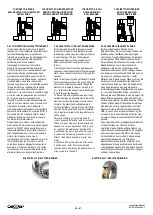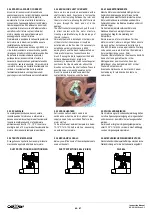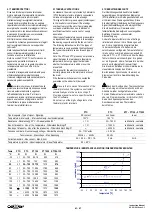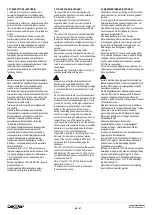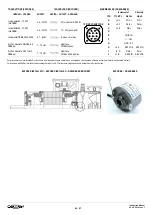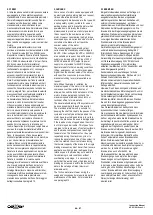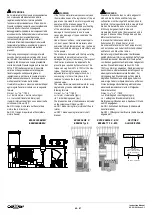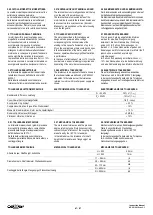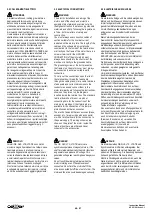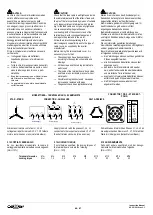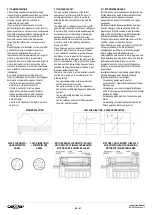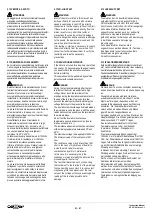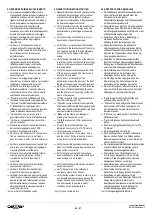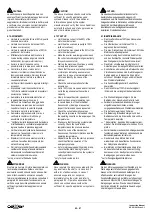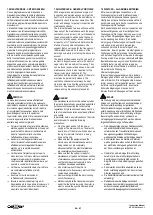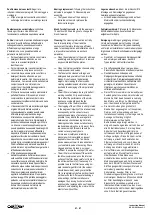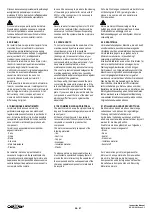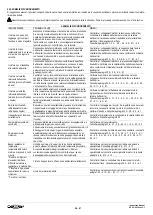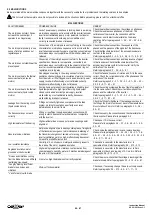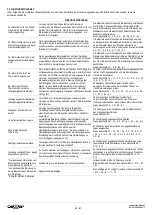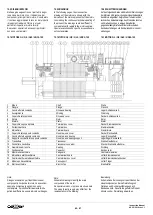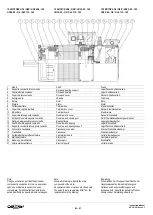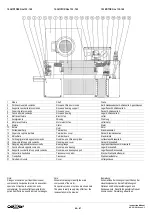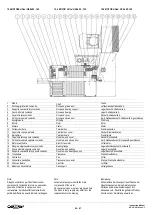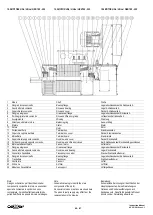
51 - 97
Instruction Manual
AC 02/2019-rev.1.1
5.12 VERIFICA A VUOTO
ATTENZIONE
La maggior parte dei motori contemplati in questo
manuale e costruiti appositamente per
funzionamento a velocità variabile tramite
alimentazione da inverter NON sono idonei per
funzionare direttamente collegati alla rete elettrica
(senza inverter). Se questi motori vengono alimentati
direttamente da rete anche per brevissimo tempo
potrebbero danneggiarsi irreparabilmente, diventare
pericolosi e provocare seri danni alle persone
presenti nelle vicinanze, alla linea elettrica ed al
quadro di alimentazione. Nel caso si rendesse
indispensabile alimentare i motori direttamente dalla
rete elettrica (per test o collaudi) consultare prima il
nostro ufficio tecnico per verificarne la possibilità e le
necessarie precauzioni da adottare.
5.12 NO-LOAD TEST
WARNING
Most of the motors listed in this manual and
built specifically for operation with variable
speed inverter supply can NOT be directly
connected to the line supply (without inverter).
If these motors are powered directly from the
mains (even for very short time) without
precautions they can be seriously damaged,
become dangerous and cause severe damage
to the people, the equipment around and the
power line /electrical cabinet.
If for testing or start-up is necessary to supply
the motors directly from the power line, first
consult our technical department to verify the
feasibility and take the necessary
precautions.
5.12 LEERLAUF TEST
WARNUNG
Die meisten der in dieser Betriebsanleitung
aufgeführten Motore sind explizit für den
Umrichter Betrieb und nicht für den direkten
Anschluss an Netzt (ohne Umrichter) ausgelegt.
Falls diese Motoren direkt an Netz
angeschlossen werden, auch nur kurzzeitig,
könnten sie irreparable beschädigt und
gefährlich werden für Personen und Ausrüstung
in der Nähe sowie die Versorgungs-
Einrichtungen.
Falls diese Motoren direkt an Netz
angeschlossen werden müssen (für Test oder
Inbetriebnahme) unser technisches Büro
konsultieren wegen notwendiger
Vorsichtsmassnahmen.
5.13 RESISTENZA DI ISOLAMENTO
Se il motore non viene utilizzato da molto tempo (olre
1 anno) oppure se ha subito modifiche /riparazioni è
necessario verificare la resistenza di isolamento
prima della reinstallazione. Questa operazione deve
essere effettuata unicamente da personale
specializzato dotato delle opportune protezioni.
PERICOLO
Durante il test ed immediatamente dopo il test i
terminali del motore sono sottoposti ad alta
tensione. Non toccare mai i terminali degli
avvolgimenti durante la prova di resistenza di
isolamento. Al termine della prova cortocircuitare
verso massa per qualche secondo i terminali gli
avvolgimenti per scaricare la tensione
eventualmente ancora presente nel motore.
La prova di isolamento deve essere effettuata tra
le fasi del motore e la massa, con i cavi di
alimentazione scollegati e solo sui terminali degli
avvolgimenti principali.
Non effettuare la prova di resistenza di
isolamento sui sensori di temperatura e sugli
accessori (scaldiglie, freni, encoders, etc…).
La misura della resistenza deve essere effettuata
con una temperatura degli avvolgimenti
compresa tra 20°C e 30°C.
La tensione massima da applicare è di 1000Vdc.
Il valore minimo di resistenza è di 10M ohm.
Il valore della resistenza potrebbe essere
inferiore a 10M ohm in caso di elevati valori di
umidità interna al motore e/o avvolgimenti
contaminati da sporco/olio/parti di metallo.
In questo caso è necessario provvedere
all’asciugatura degli avvolgimenti oppure alla
pulizia interna prima di mettere in funzione l
motore.
La prova di isolamento deve essere effettuata
collegando i cavi dello strumento ai terminali
degli avvolgimenti in modo saldo e con buon
contatto. Un contatto incerto potrebbe provocare
scintillio ed innalzamento del valore reale della
tensione con conseguente esito negativo della
prova e possibile danneggiamento del motore.
5.13 INSULATION RESISTANCE
If the motor is not used for a long time (more than
one year) or if it has undergone changes / repairs
you need to check the insulation resistance
before reinstalling.
This operation must be performed by qualified
personnel with suitable protections.
DANGER
During the test and immediately after the test
terminals of the motor are subjected to high
voltage. Never touch the terminals of the
windings during the insulation resistance test. At
the end of the test short to ground for a few
seconds the windings terminal to discharge the
voltage that may still be present in the motor.
The insulation test should be performed between
the motor phases and the ground, with the power
cables disconnected and only on the terminals of
the main windings.
Do not test the insulation resistance on
temperature sensors and accessories (heater,
brakes, encoders, etc ...).
The resistance measurement must be carried out
with a winding temperature between 20°C and
30°C.
The maximum voltage to be applied is 1000Vdc.
The minimum value of the resistance is 10M
ohm.
The resistance value may be less than 10M
ohm in the case of high values of humidity
inside the motor and/or windings
contaminated by dirt/ oil/ metal parts.
In this case it is necessary to dry the
windongs or clean internally the motor before
proceeding wth the start up.
The test shall be carried out by connecting
the instrument to the terminals of the windings
firmly and with good contact. A loose contact
may cause glitter and elevation of the real
value of the voltage with consequent negative
reading of the test and possible motor
damage.
5.13 ISOLATIONSWIDERSTAND
Falls der Motor längere Zeit nicht benutzt oder (mehr
als 1 Jahr) modifiziert/repariert wurde, ist es notwendig
den Isolationswiderstand zu prüfen vor der
Wiederinbetriebnahme. Diese Überprüfung darf nur von
ausgebildetem Personal mit entsprechender
Schutzeinrichtung ausgeführt werden.
GEFAHR
Während dem Test und unmittelbar danach liegt
an den Klemmen des Motors eine hohe Spannung
an.
Niemals die Klemmen während Isolations-
widerstandtest berühren. Nach dem Test die
Klemmen für ein paar Sekunden erden, um
eventuelle Restspannungen aus der Wicklung
abzuleiten. Die Isolationswiderstand muss
zwischen den einzelnen Phasen und Masse
geprüft, bei nicht angeschlossenen
Versorgungkabeln und nur auf den Klemmen der
Hauptwindungen. Die Wicklungstemperatur muss
dabei zwischen 20°C und 30°C liegen.
Den Isolationswiderstandtest nicht mit den
Temperatursensoren oder dem Zubehör
(Vorwärmer, Bremsen, Drehgeber etc.)
durchführen.
Die maximal angelegte Spannung beträgt
1000Vdc. Der minimale Widerstandswert ist 10M
Ohm. Der Widerstandwert könnte unter 10M Ohm
liegen, falls erhöhte Feuchtigkeit im Motorinneren
u/o mit Partikeln/Öl/Metallteilchen verunreinigte
Wicklungen vorliegen.
In diesem Fall ist es notwendig, Trocknen der
Wicklungen oder reinigen Sie den Innenraum vor
der Inbetriebnahme des Motors.
Der Test muss mit fest verbunden Kontakt der
Kable des Messinstruments mit den
Motorklemmen und gutem Kontakt ausgeführt
werden. Ein unsicherer Kontakt könnte Funken
verursachen und einen erhöhten Spannungswert
verursachen mit daraus folgendem negativem
Testergebnis und möglicher Beschädigung des
Motors.
Содержание HQCA
Страница 2: ...2 97 Instruction Manual AC 02 2019 rev 1 1...

